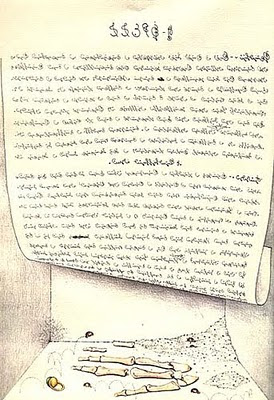"Algunos piensan que es el libro más raro que jamás se haya publicado. Un libro de arte completamente diferente a cualquier otro. Una parodia única, perturbadora y surreal. Un contraste entre lo grotesco y lo hermoso, simplemente difícil de describir. El Codex Seraphinianus, del artista italiano Luigi Serafini, es una ventana a un mundo fantástico y extraño; con un alfabeto único e indescifrable acompañado de numerosas ilustraciones de la época moderna, que cambian a lo extremadamente inusual. Franco María Ricci publicó este libro en dos volúmenes, en 1981.
El Código Seraphinianus es descrito como un libro de la “era de la información” donde la codificación y decodificación de mensajes es sumamente importante en genética, informática y crítica literaria. El código representa la visión creativa de ese tiempo.
 |
|---|
Fuente: http://www.iberlibro.com/libros/Codex-Seraphinianus.shtml
Algunas imágenes del libro:
About the CODEX - text taken from Archimedes' Lab:
"The Codex Seraphinianus was written and illustrated by Italian graphic designer and architect, Luigi Serafini during the late 1970's. The Codex is a lavishly produced book that purports to be an encyclopedia for an imaginary world in a parallel universe, with copious comments in an incomprehensible language. It is written in a florid script, entirely invented and completely illegible, and illustrated with watercolor paintings.
The Codex is divided into a number of sections (each with its own table of contents, the page numbers are in base-21 or base-22!) on subjects such as plants, animals, inhabitants, machines, clothing, architecture, numbers, cards, chemical analyses, labyrinth, Babel, foods... There are panoramic scenes of incomprehensible festivals, and diagrams of plumbing!
The Codex is to that imaginary world what Diderot's Encyclopedia is to ours. Obviously, Serafini was not just attempting to create a consistent alternate world. Rather, the Codex is sort of an elaborate parody of the real world.
The invented script of the book imitates the Western-style writing systems (left-to-right writing in rows; an alphabet with uppercase and lowercase; probably a separate set of symbols for writing numerals) but is much more curvilinear reminding some Semitic scripts. The writing seems to have been designed to appear, but not actually be, meaningful, like the Voynich Manuscript.
At is best, the Codex Seraphinianus is really diverting and surrealist; at its worst, it is tedious, kitsch, and childish. This book was surely inspired by the Voynich Manuscript and designed with the spirit of Hieronymus Bosch in mind."
Source: http://www.archimedes-lab.org/Serafi/C_serafini.html
Algunos artículos Web sobre el Codex:
En español:
http://malarrama.blogspot.com/2009/02/codex-seraphinianus.html
En inglés:
http://faculty.msvu.ca/pschwenger/codex.htm
http://www.fantasticmetropolis.com/i/codex/






















2 comentarios:
Impresionante.
No tenía conocimiento de algo tan mágico, acojonante y sorprendente.
Sí que es una obra original y hermosa. Me encantaría hojear un facsímil y qué decir de poseer un ejemplar.
Saludos,
Atrabiliario
Publicar un comentario